With Australia’s population forecast to rise to about 27 million by 2022, Population Minister Alan Tudge claims a federal government policy requiring new migrants to settle in regional areas will help reduce congestion in Sydney and Melbourne, with the policy slated to come into effect on 1 July. From The Australian:
With the population policy now a cabinet level portfolio, and Australia forecast to be home to an estimated 27 million people by 2022, Mr Tudge said he hoped the decentralisation of population growth would begin to ease pressures because of new migrants being directed or choosing to live in other parts of Australia…
“I would hope that within a couple of years we would see the impact and the easing up on the population pressure in Melbourne and Sydney especially.”
We already know that most new migrants choose to reside in Australia’s two biggest cities – Sydney and Melbourne. This was revealed in the Productivity Commission’s 2016 Migrant Intake into Australia report:
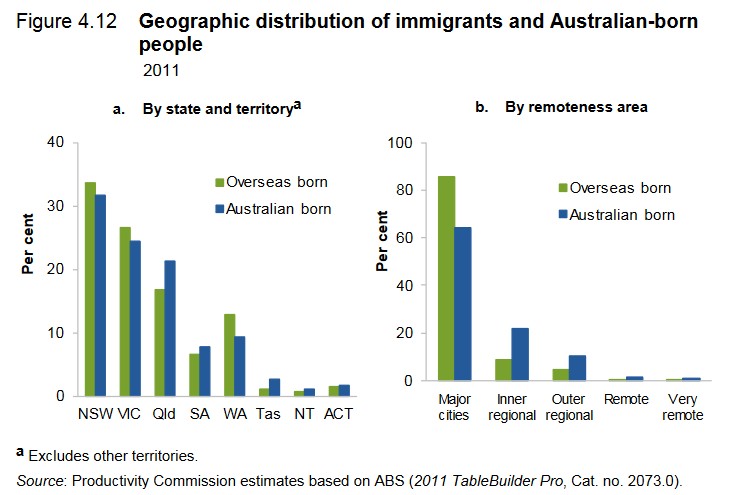
It was confirmed by the 2016 Australian Census, which revealed that 86% of new migrants (1.11 million) in the five years to 2016 settled in the capital cities, versus just 14% (187,000) that settled in regional areas over the same period.
And it was confirmed by the latest migrant settlement data from the ABS, which showed that 85% of migrants settled in the capital cities in 2017-18, with 65% alone settling in Sydney and Melbourne:
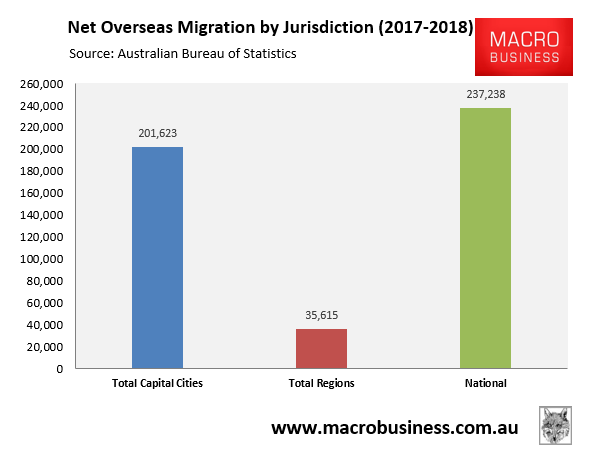
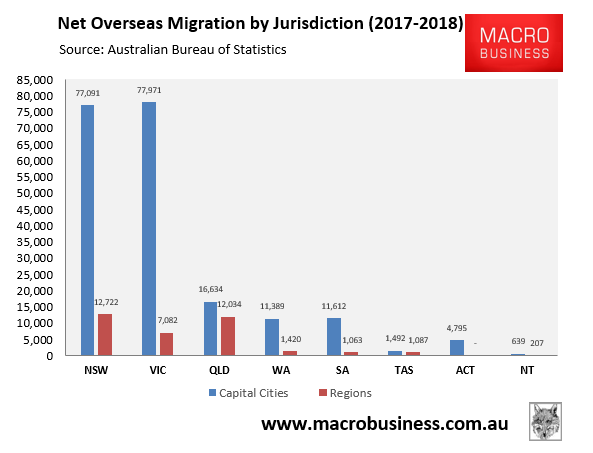
While the Coalition’s settlement policy may direct more migrants to regional areas, there is nothing to actually keep them there and most will head into the major cities once their mandatory time period is up.
Indeed, ANU research of settlement patterns, released last month, showed that 60% of migrants that moved to Australia’s regions subsequently move to the cities within five years:
An Australian National University study released Thursday found more than 60 per cent of migrants move to a capital city after about five years of living in a regional or remote location.
ANU material went as far as saying new migrants were “fleeing” regional Australia for better opportunities in the cities.
Australia has a number of visas that are designed to entice migrants to regional areas but the research suggests more needs to be done to keep them there.
ANU demographer Bernard Baffour told SBS News, “you can move migrants to areas, but you can’t force them to stay there”…
The study found Chinese-born migrants are more likely to settle in Sydney. Erin Chew of the Asian Australian Alliance said, “a lot of the Chinese people are city dwellers, so they want to live in [places] where there’s a huge concentration of their community”…
Elsewhere, Melbourne is the city of choice for most Indian-born migrants.
Indeed, state-based migration programs have been systemically gamed, with migrants temporarily settling in places like the ACT and Tasmania purely to get the required number of points for permanent residency before moving to Sydney and Melbourne.
There is also the problem of scarce water supply in the regions, with huge swathes of NSW and QLD already in drought. How are towns like Tamworth and Dubbo supposed to accommodate tens-of-thousands more people when they are already running dangerously short of water?
Let’s be real for a moment. Australia hit 25 million a few years ago and we weren’t supposed to hit that number until 2050, according to earlier ABS population projections. Now Australia’s population is going to be 27 million in just 3 years. With that level of growth, how on earth does the federal government believe that congestion will be lowered? It won’t.
Not even Infrastructure Australia (IA) believes it is possible. Modelling conducted by IA in 2018 projected that traffic congestion and access to jobs, schools, hospitals and green space will all worsen in Sydney and Melbourne as their populations balloon to a projected 7.4 million and 7.3 million people respectively by 2046, irrespective of whether these cities build up or out:
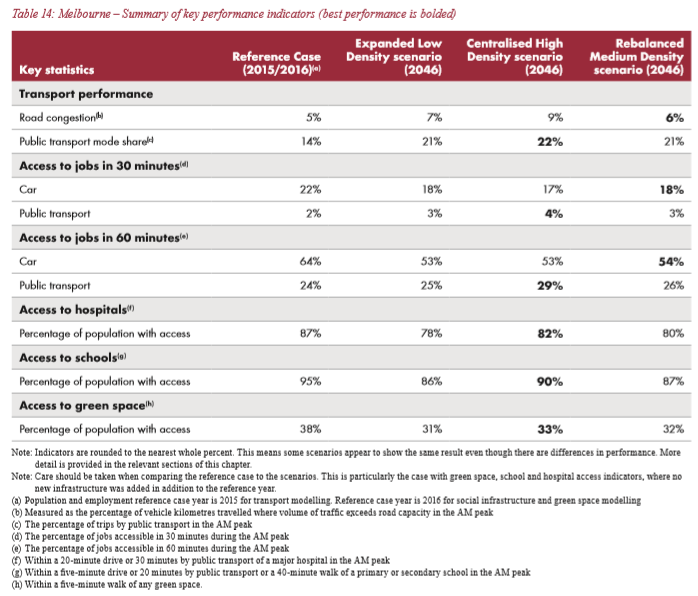
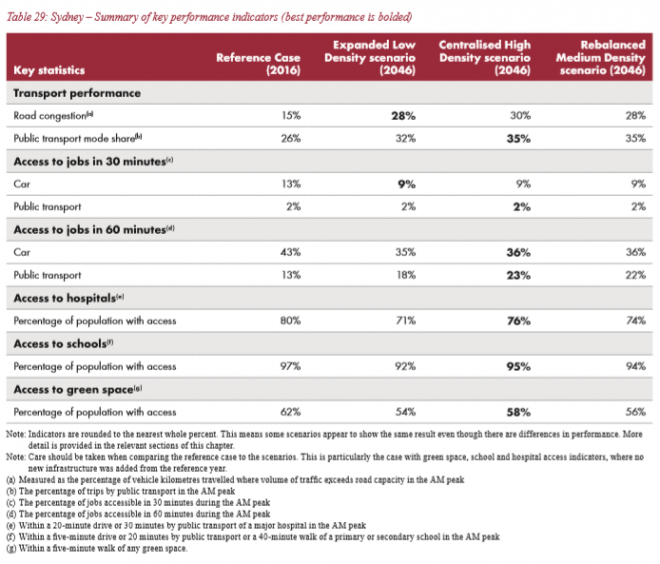
Short of erecting ‘migrant proof fences’ and electronic tags, how can decentralisation of migrants be achieved in practice when it has failed so dismally in the past, and has been systematically gamed?
The reality is that maintaining a mass immigration ‘Big Australia’ policy means that Sydney and Melbourne will continue to be crush-loaded as their populations swell to a projected 10 million people each by 2066, placing extreme further pressure on infrastructure and housing, and destroying living standards for incumbent residents:
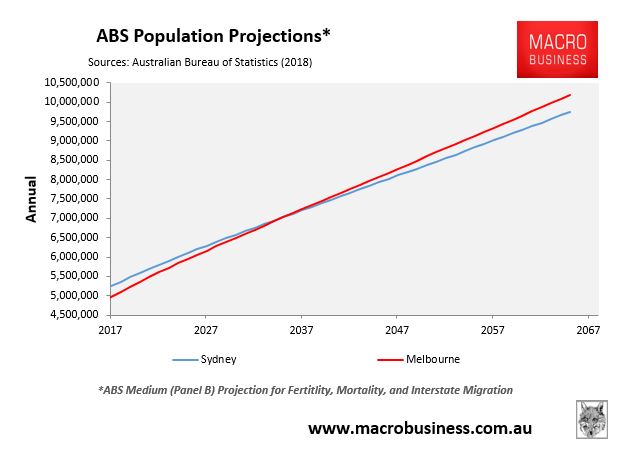
No amount of spin and propaganda can overcome these basic facts.

